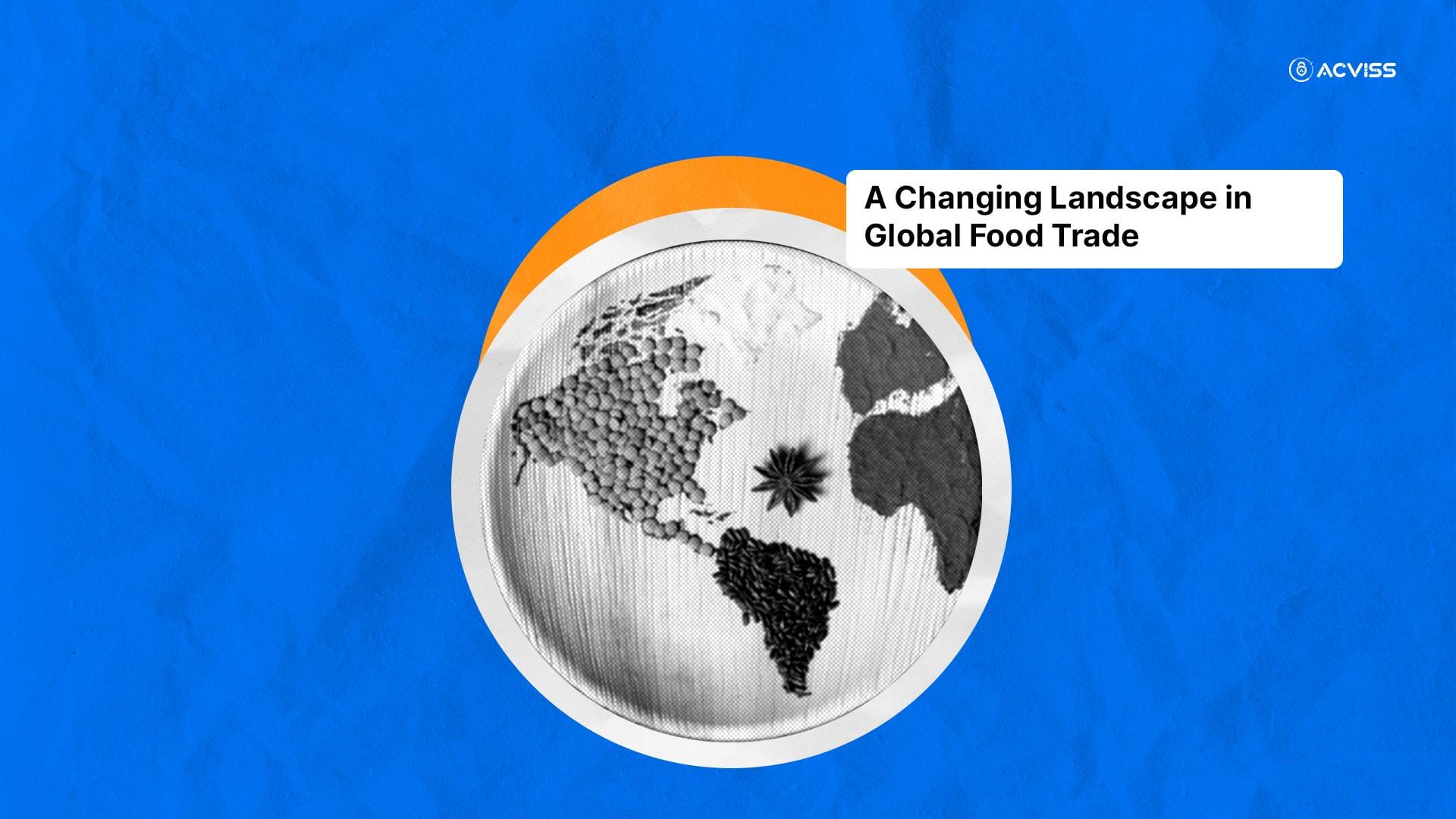The Growing Importance of Product Traceability in Global Food Trade

The food export industry has always stood on the foundation of trust. Trust that a jar of honey sourced from India is pure. Trust that a frozen meal from Thailand has been stored safely throughout its journey. Trust that a batch of coffee beans from Ethiopia reaches its destination without contamination or tampering.
But in today’s world, that trust can no longer be taken for granted. The global food trade is expanding rapidly, and with it comes a surge in complex supply chains, cross-border regulations, counterfeit risks, and consumer scrutiny. According to the Food and Agriculture Organisation (FAO), global food exports are expected to surpass US$2 trillion by 2030, fuelled by growing demand for speciality foods and healthier, sustainable options.
Yet, behind this optimistic growth lies an unsettling reality: counterfeit food products and food fraud cost the global food industry an estimated US$40 billion every year. Fake olive oil, diluted milk, mislabelled fish, and expired goods finding their way into markets have not only dented brand credibility but also posed serious threats to consumer safety.
In this environment, product traceability has emerged as the central pillar of modern supply chain management. For any food business aspiring to be export-ready, it is not just a compliance measure; it is a strategic tool for survival and growth.
Understanding Product Traceability
At its core, product traceability is the ability to track the movement of a food item, from its origin to the final consumer. It involves collecting and managing data at every stage: sourcing, production, processing, packaging, distribution, and retail.
In simpler terms, traceability answers two essential questions:
- Where did this product come from?
- Where has it been?
This system ensures transparency, accountability, and control across the supply chain. Whether it’s identifying the source of contamination during a recall or validating the authenticity of a “100% organic” label, traceability enables brands to respond swiftly and effectively.
However, for export-ready food businesses, traceability goes far beyond internal control. It becomes a passport to international markets.
Why Traceability Matters for Export-Ready Food Businesses

1. Meeting Global Food Safety Standards
Every major export destination, from the European Union to North America, mandates strict food safety and quality regulations. Frameworks such as the EU’s General Food Law Regulation (EC 178/2002), FDA’s Food Safety Modernisation Act (FSMA), and Codex Alimentarius require exporters to maintain full visibility over their supply chain.
For instance, the FSMA’s “Foreign Supplier Verification Program” obliges importers in the U.S. to ensure that the food they bring in meets U.S. safety standards. This means Indian spice exporters, Vietnamese seafood processors, or African fruit suppliers must demonstrate end-to-end track and trace capabilities.
Failure to comply can result in shipment rejections, product bans, or even permanent delisting from preferred importer networks.
2. Enhancing Brand Trust and Customer Satisfaction
Consumers across the globe are increasingly conscious about what they eat. They demand transparency about ingredients, origins, and environmental impact. A 2024 NielsenIQ survey found that 73% of global consumers are willing to pay more for brands that provide clear, traceable sourcing information.
For an export brand, traceability isn’t just about regulation; it’s about reputation. When consumers can scan a label and instantly view the farm location, manufacturing date, and batch authenticity, their trust deepens. This directly influences customer satisfaction, brand loyalty, and repeat purchases.
3. Fighting Counterfeiting and Protecting Intellectual Property
Food counterfeiting is no longer limited to luxury goods. Fake products have infiltrated markets for coffee, olive oil, honey, baby food, and even bottled water. These not only erode brand authenticity but also endanger lives.
Integrating product authentication technologies into traceability systems ensures that every product in circulation is verifiable and legitimate. Moreover, a secure traceability framework also reinforces Trademark Protection and IP Protection, preventing unauthorised replication or tampering.
4. Managing Recalls Efficiently
Product recalls can be disastrous, both financially and reputationally. According to a study by the Grocery Manufacturers Association (GMA), a single recall can cost a company anywhere between US$10 million and US$100 million, not including brand damage.
Traceability allows pinpointing the exact batch or lot affected, enabling targeted recalls rather than blanket withdrawals. This not only saves money but also maintains public trust during crises.
5. Improving Supply Chain Resilience
Export-ready food businesses often depend on multi-tier supplier networks spanning continents. A single disruption, a contaminated input, a delayed shipment, or a falsified document can trigger a domino effect.
Traceability systems provide visibility across all touchpoints, helping brands foresee risks, manage disruptions, and optimise inventory. When combined with blockchain-based track and trace systems, they create an immutable record of transactions, ensuring that every stakeholder in the chain is accountable.
The Anatomy of a Modern Traceability System
A robust track and trace system integrates a blend of digital and physical technologies. These include:
- Unique Product Identifiers: QR codes, barcodes, or digital watermarks that store product data.
- Blockchain Technology: A decentralised ledger ensuring data integrity and transparency.
- IoT Sensors: For monitoring temperature, humidity, and storage conditions in real-time.
- Cloud Databases: Central repositories to store and analyse supply chain data.
- AI and Machine Learning Algorithms: For predictive analytics and fraud detection.
Each component plays a role in strengthening visibility, preventing fraud, and improving decision-making.
Traceability as a Brand Protection Strategy
For export businesses, brand protection is inseparable from traceability. Every exported food product represents not just the brand’s name but also its trademark, reputation, and commitment to quality.
Consider a premium tea brand exporting to Europe. Without traceability, counterfeiters could easily refill their packaging with inferior blends, resell them under the same label, and damage consumer confidence. With a product verification system in place, each package carries a secure, non-replicable code linked to an authenticated database, ensuring every buyer, distributor, or regulator can verify its authenticity instantly.
This is where advanced anti-counterfeiting solutions such as Acviss Origin come into play.
How Origin Enhances Traceability and Brand Protection

Acviss Origin offers an integrated track and trace ecosystem built on blockchain technology. It enables food businesses to trace their products through every stage of the supply chain, from sourcing raw materials to reaching global retailers.
Each unit is tagged with a non-cloneable label, a unique digital identity that ensures no two products share the same code. This acts as an immutable proof of authenticity, allowing stakeholders and consumers to verify origin, manufacturing details, and movement history instantly.
For exporters, this means complete product authentication and protection against counterfeiting, grey market trading, and unauthorised diversions. Moreover, the data insights derived from Origin empower brands to make informed decisions, identifying bottlenecks, improving supplier accountability, and optimising logistics.
Beyond compliance, it fosters customer engagement. When consumers scan the code, they don’t just verify authenticity; they connect with the story behind the product, the farm it came from, its journey, and the brand’s sustainability practices. This emotional connection drives loyalty and enhances the perception of brand verification and reliability in global markets.
Technology-Driven Transformation in Food Exports
The global shift towards digital supply chain management is transforming how food exporters operate.
- Blockchain provides tamper-proof transparency across multiple stakeholders.
- AI and Machine Learning detect anomalies or deviations in shipment data, flagging potential fraud.
- IoT devices ensure that perishable goods like dairy or seafood remain within safe temperature ranges.
- Cloud-based dashboards provide real-time visibility to exporters, regulators, and importers.
A recent report by PwC revealed that companies investing in digital traceability technologies experienced a 30% reduction in supply chain losses and a 25% increase in operational efficiency.
In essence, traceability isn’t an expense; it’s an investment that delivers measurable returns.
The Interconnection of Traceability, IP, and Product Safety
Intellectual Property (IP) and Trademark Protection form the foundation of brand identity. When counterfeiters imitate packaging, labels, or brand names, they not only violate IP rights but also jeopardise consumer safety.
Traceability technologies reinforce IP protection by linking every product to its legitimate source. It becomes impossible for counterfeiters to reproduce the same chain of data, the blockchain record, non-cloneable label, or timestamped production log.
Moreover, product safety benefits immensely. With traceability in place, brands can ensure temperature consistency, ingredient compliance, and hygiene standards throughout the production and transportation cycle. It provides a digital audit trail that regulators and customers can trust.
Challenges in Implementing Traceability
While the benefits are undeniable, achieving seamless traceability isn’t without challenges.
- Data Standardisation: Different countries and agencies use different traceability protocols. Harmonising them remains complex.
- Cost and Infrastructure: Implementing blockchain, IoT sensors, or AI systems can be expensive for small exporters.
- Supplier Resistance: Many upstream suppliers still rely on manual documentation, limiting data transparency.
- Cybersecurity Threats: As traceability moves digital, protecting sensitive supply chain data becomes crucial.
However, with the right partner and the right solution, these challenges can be mitigated. Solutions like Acviss Origin integrate seamlessly with existing ERP and warehouse systems, reducing implementation friction while ensuring compliance and security.
Case in Point: When Traceability Saved a Brand
In 2022, a European dairy exporter faced a recall due to suspected contamination in a batch of cheese sold across three continents. However, because their track and trace system captured every movement and storage condition, they could isolate the issue to a single supplier’s batch.
Instead of recalling 500,000 units, they withdrew only 20,000, saving millions in potential losses. The quick, transparent communication also restored consumer confidence almost instantly.
This is the tangible power of traceability; it transforms crisis management into a demonstration of integrity.
The Road Ahead: Traceability as a Competitive Advantage

As the world moves towards sustainability and responsible sourcing, product traceability is becoming a core differentiator. Exporters who invest in transparent, data-driven supply chains will not only comply with evolving regulations but will also gain market preference.
Consumers, regulators, and distributors are all leaning towards brands that can prove what they claim. Whether it’s “organic,” “sustainably farmed,” or “made in India,” the proof lies in traceability.
Over the next decade, as digital ecosystems evolve, we can expect integration between traceability, brand protection, and consumer engagement platforms, creating unified systems where every product tells its own verified story.
Final Thoughts
In the era of connected consumers and digital supply chains, traceability is not an option; it’s an expectation. It’s how brands demonstrate accountability, protect their intellectual property, and build lasting consumer relationships.
Food businesses preparing for export must recognise that their success abroad will depend not just on taste or price, but on trust, trust that is earned through visibility, authenticity, and protection.
Interested to learn more about how traceability and brand protection can help your export business thrive? Get in touch with us today to discover how Acviss Origin can make your brand truly export-ready.
